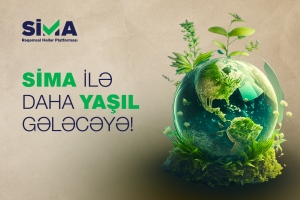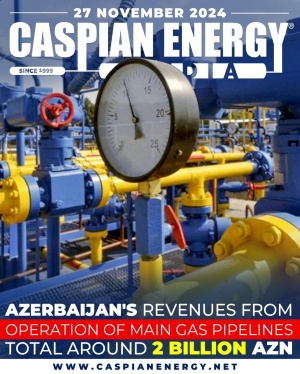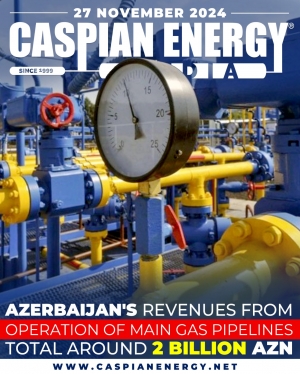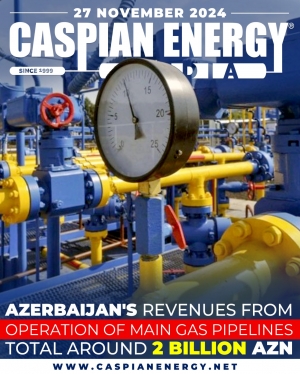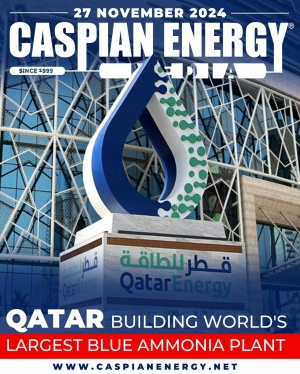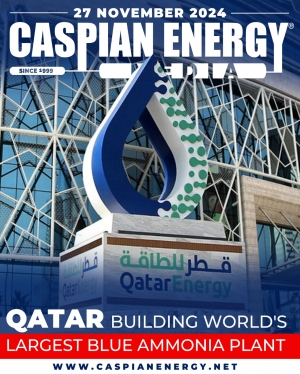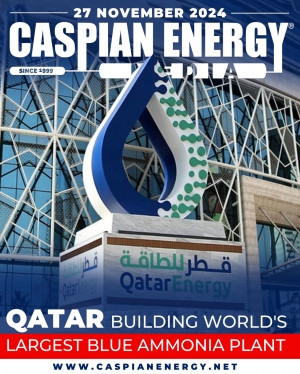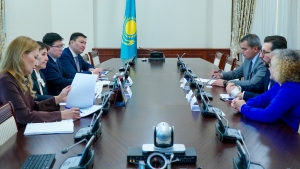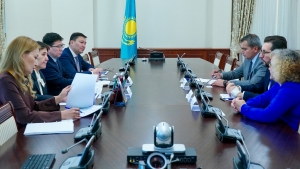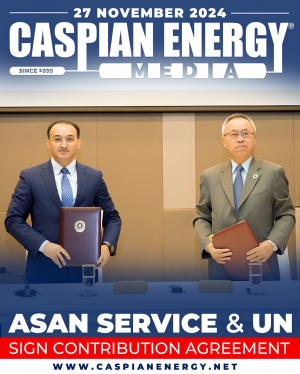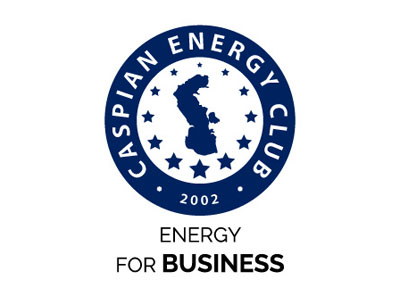Super User
SİMA minlərlə ağacın qorunmasına töhfə verir
Rəqəmsal İnkişaf və Nəqliyyat Nazirliyinin tabeliyində olan “AzInTelecom” MMC tərəfindən yaradılmış SİMA yeni nəsil rəqəmsal imza olaraq ekoloji problemlərin həllinə və dayanıqlı inkişaf məqsədlərinə töhfə verməyə davam edir. SİMA-nın məqsədi rəqəmsallaşmanın geniş tətbiqi vasitəsilə daha yaşıl və dayanıqlı gələcəyə yol açmaqdır.
SİMA yeni nəsil rəqəmsal imzadan istifadə ağacların kəsilməsinin, dolayı yolla təbiətdəki yaşıllığın azalmasının qarşısını alır. Kağız istehsalının azaldılması isə həm də istehsal prosesi zamanı sərf olunan su və enerji ehtiyatlarına da qənaət etmə imkanı yaradır.
Bu barədə “Caspian Energy Media” “AzInTelecom”-a istinadən xəbər verir.
Azərbaycanın magistral qaz kəmərlərinin istismarından əldə olunan gəlir 2 milyard manata yaxındır
Bu ilin yanvar-sentyabr aylarında Azərbaycanın magistral qaz kəmərləri ilə yükdaşımalardan əldə etdiyi gəlirləri 1 999 005 min manat təşkil edib, bu da illik müqayisədə 5,7% artım deməkdir.
Ötən ilin müvafiq dövründə sözügedən göstərici 1 891 727,3 min manat səviyyəsində olub.
Azerbaijan's revenues from operation of main gas pipelines total around 2 billion AZN
In January-September of this year, Azerbaijan's revenues from cargo transportation via main gas pipelines amounted to AZN 1,999,005 thousand, which is an increase of 5.7% in comparison with the previous year.
In the corresponding period of last year, the mentioned indicator was at the level of AZN 1,891,727.3 thousand.
Доходы Азербайджана от деятельности магистральных газопроводов составили около 2 млрд манатов
Доходы от деятельности магистральных газопроводов Азербайджана, включая Южно-Кавказский трубопровод (ЮКТМ), в январе-сентябре 2024 года составили 1 млрд 999,005 млн, что на 5,7% выше показателя аналогичного периода прошлого года.
Потери в сети магистральных газопроводов по итогам января-сентября 2024 года снизились на 41,6% - до 29,6 млн кубометров.
По магистральным газопроводам за 9 месяцев 2024 года было транспортировано 29 млрд 571,3 млн кубометров газа (рост на 0,5%). При этом, 56,8% всего прокачанного объема пришлось на долю Южно-Кавказской трубопроводной магистрали.
Qətərdə dünyanın ən böyük mavi ammonyak zavodu tikilir
Qətər dünyanın ən böyük mavi ammonyak zavodunu tikir.
Qətər əmiri Təmim bin Həməd Al Taninin iştirakı ilə sənaye şəhəri Mesaiddə zavodun təməli qoyulub. Zavodun tikintisi “QatarEnergy”nin ən iddialı layihələrindən biri kimi təsvir edilib.
Zavod ildə 1,2 milyon ton ammonyak istehsal edəcək və 1,5 milyon ton tutumu olan CO2 anbarı ilə təchiz ediləcək. Yeni stansiya 35 MVt gücündə günəş elektrik stansiyasından enerji alacaq.
Mavi ammonyak təbii qaz və kömürdən istifadə etməklə istehsal olunan ammonyakdır, lakin yandırıldıqda təmiz təbii qazdan daha az karbon qazı əmələ gətirir. Onun ənənəvi yanacağın "yaşıl" əvəzedicisi ola biləcəyinə inanılır.
Катар строит крупнейший в мире завод по производству голубого аммиака
Катар строит крупнейший в мире завод по выработке голубого аммиака.
Первый камень в основание завода был заложен в промышленном городе Месаид при участии эмира Катара Тамима бен Хамада Аль Тани. Строительство завода в Месаиде было названо одним из самых амбициозных проектов QatarEnergy.
Завод будет ежегодно производить 1,2 млн т аммиака и будет оснащен блоком для хранения CO2 мощностью 1,5 млн т в год. Питание нового завода будет обеспечивать солнечная электростанция мощностью 35 МВт.
Qatar building world's largest blue ammonia plant
QatarEnergy announced that the groundbreaking ceremony for the world's largest blue ammonia plant took place in Mesaieed Industrial City, about 40 km south of the Qatari capital Doha.
“This facility consists of an ammonia production unit with a capacity of 1.2 million tons per year, along with an additional unit for CO2 injection and storage, with a capacity of 1.5 million tons per year,” Saad Sherida Al-Kaabi, Qatar’s minister of State for Energy Affairs and President and CEO of QatarEnergy, was quoted as saying in a statement released by QatarEnergy.
“QatarEnergy will provide the new plant with more than 35 megawatts of electricity from the solar power plant currently being built in Mesaieed Industrial City, thereby making it blue ammonia,” he added.
With an investment of about 4.4 billion Qatari riyals ($1.2 billion), the plant will be developed in cooperation between QatarEnergy and Qatar Fertiliser Company.
EBRD ready to support social projects in Kazakhstan
Deputy Prime Minister of the Republic of Kazakhstan Tamara Duisenova met with Managing Director of the European Bank for Reconstruction and Development for Central Asia and Mongolia Hussein Ozkhan.
Hüseyin Özkhan stressed that the EBRD is ready to develop co-operation in the social sphere. He also expressed readiness to consider the proposed projects together with the interested state bodies and other international financial institutions.
“Caspian Energy Media” reports with reference to the Press Service of the Government of the Republic of Kazakhstan.
Европейский банк реконструкции и развития готов поддержать социальные проекты в Казахстане
Заместитель Премьер-министра РК Тамара Дуйсенова встретилась с управляющим директором Европейского банка реконструкции и развития по Центральной Азии и Монголии Хусейном Озханом.
Хусейн Озхан подчеркнул, что ЕБРР готов развивать сотрудничество в социальной сфере. Также он выразил готовность к рассмотрению предложенных проектов совместно с заинтересованными государственными органами и другими международными финансовыми институтами.
Об этом сообщает “Caspian Energy Media” со ссылкой на Пресс-службу Правительства Республики Казахстан.
ASAN Service and UN sign contribution agreement
Ulvi Mehdiyev, Chairman of the State Agency for Public Service and Social Innovations under the President of Azerbaijan, and Li Junhua, United Nations Under-Secretary-General for Economic and Social Affairs, signed a contribution agreement.
The agreement envisions the application of innovations for the provision of public services based on the "ASAN Service" model in UN member countries, as well as the development of potential in the relevant field.
In line with the experience of Azerbaijan's "ASAN service,” trainings on advanced management and provision of public services will be organized for public servants in the relevant countries. Textbooks will be prepared, and international events will be held as well.




